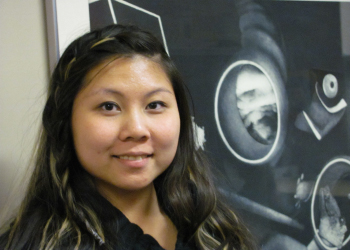
Wing’s Master’s projects compared activation ratios of neuronal populations across hippocampal subregions through the use of immediate-early gene activation analyses. Immediate-early genes are synaptic activity markers whose intranuclear transcription foci appear at distinct temporal intervals after synaptic activation. Wing’s Master’s thesis described non-Boolean characteristics of Homer1a transcription foci. Homer1a is an immediate-early gene whose transcription is triggered by synaptic activity and its gene products are implicated in plasticity and learning and memory processes. These non-Boolean aspects (such as integrated intensity and foci volume) may correlate with neuronal firing rates, a measure previously thought to be obsolete due to the intensive amplification steps during in situ hybridization. Studies are currently underway to validate these speculations through systematic place cell traversals and corresponding foci size and intensity.
In addition, Wing is interested in the direct and indirect interactions between hippocampal subregions and their downstream cortical regions. Wing has studied activation properties of the dorsal subiculum, an important hippocampal output structure. She observed that dorsal subiculum cells are highly active and activation proportions do not seem to discriminate between the number of different environments experience, contradictory to previous findings in CA1 and CA3. Wing will continue to study the properties of dorsal subiculum cells both in firing characteristics and connectivity with cortical regions by combing immediate-early gene activation analyses with retro/anterograde tracing methods. Furthermore, Wing is currently studying the effect of hippocampal lesions on superficial cortical activity through the use of voltage-sensitive dyes.
Degrees
- Master of Science (2012) University of Lethbridge
- Bachelor of Science in Psychological Sciences (2009) University of Alberta
- Bachelor of Science in Biological Sciences (2009) University of Alberta
Contributions
- Chemla, S., Witharana, W. K., & McNaughton, B. L. Spatiotemporal after-effects of transcranial direct current stimulation on sensory-evoked activity in rat S1: A pilot VSDI study. Curr Neurobiol 2016, 7(2): 30-35.
- Witharana, W.K.L., Clark, B.J., Trivedi, V., Lapointe, V., and McNaughton, B.L. (2012) Integrated fluorescence intensity of Homer1a transcription foci indicate integrated neuronal firing rates. Society for Neuroscience Annual International Meeting: Neuroscience 2012 (Oct 12- 17), New Orleans, LA, USA. (Poster)
- Witharana, W.K.L., Trivedi, V., and McNaughton, B.L. (2012) Homer1a intranuclear foci vary in size and intensity depending on behavioral conditions. Alberta Graduate Conference. Edmonton, AB, Canada. May 5, 2012. (Poster).
- Li, W. K., and McNaughton, B.L. (2012) Non-Boolean characterization of Homer1a intranuclear transcription foci. Oral presentation. Spring Conference on Brain and Behaviour. Fernie, BC, Canada. February 24, 2012.
- Witharana, W.K.L. (2011). Non-Boolean characterization of Homer1a intranuclear transcription foci. Master of Science Thesis. University of Lethbridge. Lethbridge AB.
- Witharana, W.K.L., Trivedi, V., and McNaughton, B.L. (2011) Homer1a intranuclear foci vary in size and intensity depending on behavioural conditions, but not on hippocampal subregions. Society for Neuroscience Annual International Meeting: Neuroscience 2011 (Nov 12-16), Washington, DC, USA. (Poster)
- Li, W.K., and McNaughton, B.L. (2011) Refinement of immediate-early gene activation analyses to derive neuronal population activity patterns. Canadian Spring Conference for Behaviour and Brain (Feb. 19), Fernie, BC, Canada. (Oral Pres., National Meeting)
- Li, W.K.*, and McNaughton, B.L. (2010) Confirmation by immediate-early gene activation analysis of non-sparse coding in subiculum during spatial behavior. Society for Neuroscience Annual International Meeting: Neuroscience 2010 (Nov. 13-17), San Diego, CA, USA.